Welcome to a new year and a time for refreshed effort
By Andrew Ford, VFBV Chief Executive Officer
As I write this editorial we head into the New Year festivities and recover from our Christmas celebrations. Hopefully each of you have had a chance to relax (at least at some point) and enjoy Christmas with people you love or doing something you love.
We head into 2018 after an interesting 2017 to say the least and as always there are heaps of issues on the go and/or emerging. For now I want to focus on one key issue and that is welcoming the recently appointed CFA CEO Dr Paul Smith who will start work with CFA early in the New Year.
Since the formation of CFA, volunteers have welcomed many a new leader to the organisation. As those that have come before, Paul will become a key custodian of our proud organisations hopes and legacy. As volunteers, we have a proud record of embracing the new and looking positively to the future, knowing that it would take a very hard person indeed not to be touched by the wonderful community based organisation they are joining, I have no doubt that Paul’s commencement will mark a positive chapter in CFA’s long and proud history.
I personally look forward to a great collaborative relationship with Paul who brings a wealth of experience and from my networks a deserved reputation of being a values driven leader and person of high integrity. Paul has experience with CFA and the emergency sector and on behalf of all volunteers I say welcome and congratulations on your appointment Paul.
2017 VFBV Volunteer Welfare & Efficiency Survey – Interim Results
As you can see the main feature of this month’s page is a summary of the 2017 VFBV Welfare and Efficiency Survey and I encourage you to take time to understand the key results.
This year’s VFBV Volunteer Welfare & Efficiency survey closed at the end of October, with analysis now underway to compile this year’s full results. The final detailed report will be provided very soon, but in the meantime, we are providing some interim, high level results.
This year was the sixth consecutive year we have conducted the survey. We would like to the thank the 2,653 CFA participants who completed the survey this year. This is an outstanding result and the survey remains the largest survey of its kind within CFA and probably across the emergency sector, eclipsing other survey response rates by a significant margin.
This was also the second year in a row that VFBV has managed the survey Nationally for fire agencies across the country, and also the second year VFBV has managed the survey across the Victorian emergency volunteer sector, including 6 emergency management agencies across the state to give a Victorian emergency sector perspective. The annual survey broke a new record Nationally, with a total of 7,727 respondents across Australia. This represents the largest survey of emergency management volunteers across the country.
The VFBV Welfare and Efficiency survey is an important tool, used by us to work with CFA, government and key stakeholders to provide evidence based feedback on matters affecting the welfare and efficiency of CFA volunteers. The survey continues to be valuable in providing feedback on what is going well and where things can be improved.
Back in 2012, armed with only an idea - we workshopped the survey’s design and structure with volunteers across the State, running a number of facilitated workshops and focus groups. By the end of this process, we had feedback and representation from volunteers from every single CFA District across the State.
The survey was designed by and for volunteers, to better understand the issues as volunteers see them and to measure and understand how satisfied volunteers are with arrangements in place to support, encourage and enable them to do their work.
VFBV is extremely proud of the survey’s integrity and success, and we continue to devote considerable energy to the survey’s analysis, with the hope that CFA will continue to embrace the survey’s results and drive real improvement and tangible outcomes that directly address volunteers views and feedback.
The VFBV Welfare and Efficiency survey is making a difference and has certainly focussed attention of key policy and decision makers, sector leaders and volunteer support people to the issues seen as important to volunteers. The survey has been instrumental in shaping significant investment in a range of recently announced volunteer support, training and engagement initiatives.
One of the fundamental strengths of the survey is that it is a survey designed by and run by volunteers, providing an evidence based and unfiltered reflection of what volunteers are experiencing on the ground. As the name suggests, because the VFBV Welfare and Efficiency Survey is run by VFBV, it provides a volunteers assessment of how things are, rather than someone else’s assessment of what they think volunteers are experiencing.
It is VFBV’s legislated role to understand and bring to the attention of decision makers, issues affecting the welfare and efficiency of volunteers and this survey provides one of the most powerful tools for individual volunteers to communicate their assessment of how things are going to decision makers.
Thank you to everyone who participated in the survey this year and also in previous years. The old adage of ‘what gets measured gets done’ holds true and the ongoing trends now available from this survey will become an ever more valuable tool to influence areas requiring improvement and for identifying and sharing things that are working well.
VFBV will be running the survey again in 2018 so in addition to staying tuned for the detailed report, also make a note to participate again in the survey next year.
Thanks again to everyone involved.
2017 VFBV Volunteer Welfare and Efficiency Survey
Who participated
The VFBV Volunteer Welfare and Efficiency Survey, to the best of our knowledge, is now one of the largest volunteer surveys ever conducted. Participation is strengthened by the additional involvement of fire service volunteers in most States, the Victorian State Emergency Service Volunteer Association and other emergency management volunteer involving organisations in Victoria.
CFA Respondents
- 81% Male, 18% Female (nb: <1% indicated a different category).
- All age groups, roughly reflecting CFA’s age demographic, from long serving volunteers right through to those who’ve only been with the CFA for less than a year.
- Brigade Type:
- 63% volunteers with rural brigades
- 29% volunteers with urban brigades
- 7% volunteers with integrated brigades
- <1% volunteers with a CFA Coast Guard brigade
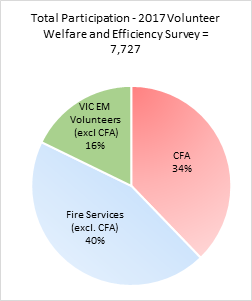
Interim Results: Initial Findings
- Volunteers are most satisfied, and expectations are closest to being met, at a local brigade level.
- Volunteers feel the time they devote to CFA is productive and worthwhile.
- Consultation with CFA volunteers at a Corporate and Regional level is where volunteer expectations are furthest from being met.
- Volunteers would like to see an improvement in the accessibility and flexibility of training, but this has improved slightly since last year.
- Acceptance of Diversity, no barriers to roles women can occupy within the brigade and a welcoming brigade are extremely important to CFA volunteers, and something they feel is done well.
- CFA’s policies, leadership and workforce arrangements which support an effective volunteer based and fully integrated organisation scored poorly, particularly by volunteers with integrated brigades.
- Recruitment and retention of younger volunteers continues to be seen as a challenge.
- Results for respondents who indicated they are members of rural brigades recorded the highest performance results in all themes.
- There is not a lot of difference in the results between the different genders, but females scored statements relating to brigade level slightly worse than males.
- Respondents identifying as volunteer members with integrated brigades recorded the lowest results across the themes, particularly in the theme “People Management – My Brigade”
- The only exception was in the area of Training, where respondents from urban brigades were less satisfied.
- The only exception was in the area of Training, where respondents from urban brigades were less satisfied.
- Respondents to the survey with less than one year of service were most satisfied. This satisfaction dropped significantly after one year, and then again after five years.
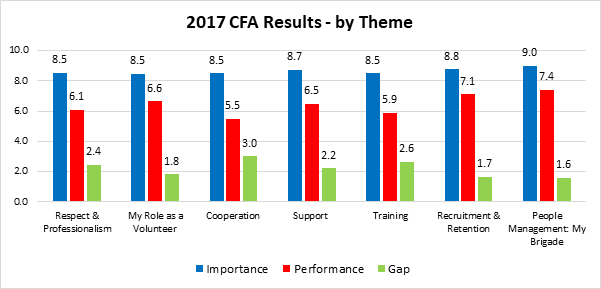
Interim Results: Satisfaction
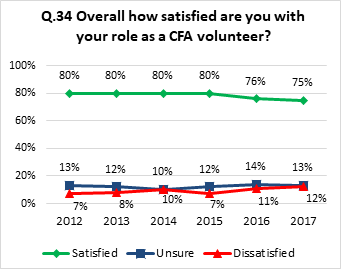
The overall number of volunteers satisfied with being a CFA volunteer continues to decline.
Volunteers with Integrated brigades are significantly less content with only 57% indicating they are satisfied. 78% of volunteers with rural brigades and 74% of volunteers with urban brigades indicated they are satisfied.
70% of volunteers who identified as brigade members are satisfied, compared to 79% who identified as being in leadership roles.
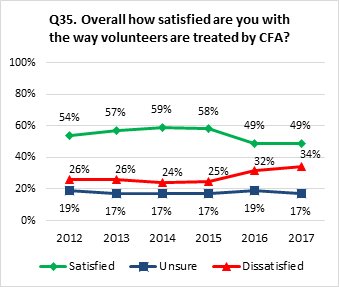
Satisfaction with the way volunteers are treated by CFA is showing no sign of improvement and is a figure that should be of significant concern to CFA.
Lower than the overall rating, only 42% of volunteers in broader leadership roles indicated they are satisfied.
59% of females compared to 46% of males are satisfied with the way they volunteers are treated by CFA.
Only 38% of volunteers who identified as members of integrated brigades indicated they are satisfied, with 43% indicating they are dissatisfied. Volunteers with rural brigades showed the highest satisfaction levels for this question with 53% indicating they are satisfied. The number of volunteers with urban brigades who indicated they are satisfied was 42%.
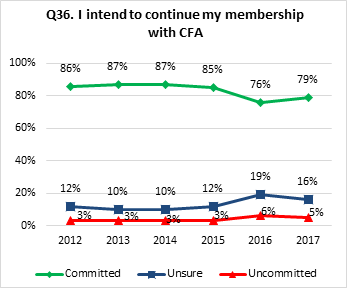
Overall, there has been a slight improvement in those intending to continue their membership with CFA, however the results reviewed by brigade type is important to be understood.
Only 60% of volunteers with integrated brigades indicated they intend to continue volunteerimg, down from 66% in 2016. This is in contrast with volunteers in rural brigades where 82% have indicated they intend to continue (up from 77% in 2016). The ratings for volunteers with urban brigades remains consistent with 2016 at 77%.
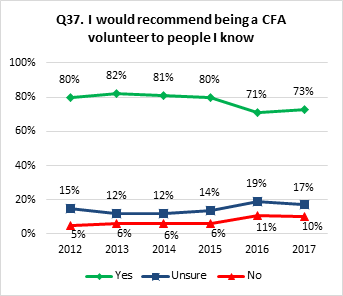
Overall another slightly improved result with an increase in the percentage of volunteers who would recommend being a CFA volunteer to others.
Again, the results of volunteers with integrated brigades being least satisfied is evident here. Only 50% of these volunteers indicated they would recommend being a CFA volunteer to others, this was 61% in 2016. Results for volunteers with rural brigades has increased to 77% now recommending being a CFA volunteer, compared with 73% in 2016. The results for volunteers with urban brigades remains steady at 70%.
Medium Tanker Survey Open
The Medium Tanker survey remains open, and volunteers are invited to provide feedback on the current Medium Tanker build.
An initiative of the Equipment & Infrastructure Committee - the purpose of the survey is to gather feedback from Brigades that have been issued with (or have familiarity with) the Medium Tankers and assess how the cab chassis, locker configuration and base equipment is operating, and if there are any areas of improvement that could be suggested for future builds.
The Committee is keen for feedback from any members who wish to provide their thoughts and experiences of how the Medium Tankers are working in the field.
If you have any feedback or design ideas that you think would benefit future builds – please get involved.
The survey can be found art the top of the VFBV website.
 About
About 
